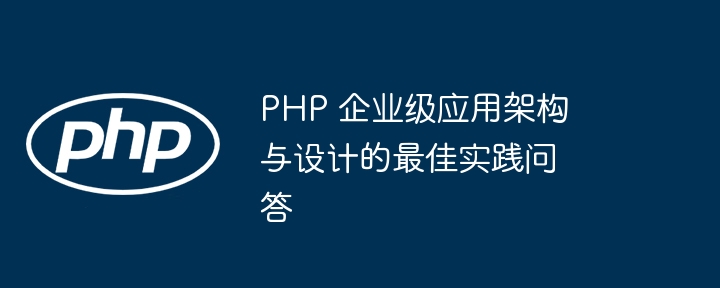 Backend Development
Backend Development
 PHP Tutorial
PHP Tutorial
 Best practices Q&A on PHP enterprise application architecture and design
Best practices Q&A on PHP enterprise application architecture and design
Best practices Q&A on PHP enterprise application architecture and design
Best practice: Layered architecture: modular, reusable, separation of concerns, improved testability. MVC pattern: clear structure, loose coupling, easy to maintain. Database connection management: connection pool, connection reuse, connection pool limit, timeout settings. Composer manages dependencies (practical): install Composer, create composer.json file, run Composer installation, and use dependencies.

PHP Best Practice Q&A on Enterprise Application Architecture and Design
1. What is a layered architecture? What are its benefits in enterprise applications?
Q: A layered architecture divides an application into multiple logical layers, each with different responsibilities. Is this a best practice for enterprise-level applications?
Answer: Yes, layered architecture provides the following benefits:
- Modularity: Applications are easy to maintain and extend.
- Reusable: Code can be reused across different layers and applications.
- Separation of concerns: Developers can focus on the functions of specific layers and improve development efficiency.
- Testability: Each layer can be tested independently to improve code quality.
2. What role does the MVC pattern play in enterprise applications?
Q: How does the Model-View-Controller (MVC) pattern help me organize my code and keep business logic separate from the presentation layer?
Answer: The MVC pattern organizes application logic into the following components:
- ##Model: Represents application data and business logic.
- View: Responsible for presenting data to users.
- Controller: Handles user interaction and acts as a bridge between the model and the view.
- Clear code structure: The code is organized and easy to understand.
- Loose coupling: The model can be updated independently of the view.
- Easy to maintain: Changing the view does not affect the model and vice versa.
3. How to manage database connections in enterprise applications?
Q: Large applications require efficient management of database connections. What are the best practices for optimizing connection pools?
Answer: Best practices for managing database connections include:
- Connection pooling: Create a connection pool to avoid having to wait for each query The cost of creating a new connection.
- Connection reuse: Reduce the number of connection creations by reusing connections between requests.
- Connection pool limit: Set the maximum number of connections for the connection pool to prevent resource exhaustion.
- Timeout settings: Set a timeout value for idle connections to release unused connections.
4. Practical case: Use Composer to manage PHP dependencies
Question: Composer is the best way to manage PHP dependencies ? Please provide a practical case.
Answer:
Step 1: Install Composer
curl -sS https://getcomposer.org /installer | php
Step 2: Create composer.json file
{
"require": {
"monolog/monolog": "^2.8",
"symfony/yaml": "^5.4"
}
}Step 3: Run Composer to install dependencies
composer install
Step 4: Using dependencies
use Monolog\Logger;
use Monolog\Handler\StreamHandler;
$logger = new Logger('name');
$logger->pushHandler(new StreamHandler('app.log', Logger::INFO));
$logger->info('Hello World!');The above is the detailed content of Best practices Q&A on PHP enterprise application architecture and design. For more information, please follow other related articles on the PHP Chinese website!

Hot AI Tools

Undresser.AI Undress
AI-powered app for creating realistic nude photos

AI Clothes Remover
Online AI tool for removing clothes from photos.

Undress AI Tool
Undress images for free

Clothoff.io
AI clothes remover

AI Hentai Generator
Generate AI Hentai for free.

Hot Article

Hot Tools

Notepad++7.3.1
Easy-to-use and free code editor

SublimeText3 Chinese version
Chinese version, very easy to use

Zend Studio 13.0.1
Powerful PHP integrated development environment

Dreamweaver CS6
Visual web development tools

SublimeText3 Mac version
God-level code editing software (SublimeText3)

Hot Topics
 1371
1371
 52
52
 PHP 8.4 Installation and Upgrade guide for Ubuntu and Debian
Dec 24, 2024 pm 04:42 PM
PHP 8.4 Installation and Upgrade guide for Ubuntu and Debian
Dec 24, 2024 pm 04:42 PM
PHP 8.4 brings several new features, security improvements, and performance improvements with healthy amounts of feature deprecations and removals. This guide explains how to install PHP 8.4 or upgrade to PHP 8.4 on Ubuntu, Debian, or their derivati
 CakePHP Date and Time
Sep 10, 2024 pm 05:27 PM
CakePHP Date and Time
Sep 10, 2024 pm 05:27 PM
To work with date and time in cakephp4, we are going to make use of the available FrozenTime class.
 CakePHP File upload
Sep 10, 2024 pm 05:27 PM
CakePHP File upload
Sep 10, 2024 pm 05:27 PM
To work on file upload we are going to use the form helper. Here, is an example for file upload.
 Discuss CakePHP
Sep 10, 2024 pm 05:28 PM
Discuss CakePHP
Sep 10, 2024 pm 05:28 PM
CakePHP is an open-source framework for PHP. It is intended to make developing, deploying and maintaining applications much easier. CakePHP is based on a MVC-like architecture that is both powerful and easy to grasp. Models, Views, and Controllers gu
 CakePHP Creating Validators
Sep 10, 2024 pm 05:26 PM
CakePHP Creating Validators
Sep 10, 2024 pm 05:26 PM
Validator can be created by adding the following two lines in the controller.
 CakePHP Logging
Sep 10, 2024 pm 05:26 PM
CakePHP Logging
Sep 10, 2024 pm 05:26 PM
Logging in CakePHP is a very easy task. You just have to use one function. You can log errors, exceptions, user activities, action taken by users, for any background process like cronjob. Logging data in CakePHP is easy. The log() function is provide
 How To Set Up Visual Studio Code (VS Code) for PHP Development
Dec 20, 2024 am 11:31 AM
How To Set Up Visual Studio Code (VS Code) for PHP Development
Dec 20, 2024 am 11:31 AM
Visual Studio Code, also known as VS Code, is a free source code editor — or integrated development environment (IDE) — available for all major operating systems. With a large collection of extensions for many programming languages, VS Code can be c
 CakePHP Services
Sep 10, 2024 pm 05:26 PM
CakePHP Services
Sep 10, 2024 pm 05:26 PM
This chapter deals with the information about the authentication process available in CakePHP.



